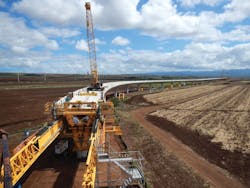NO. 4 BRIDGE: Paradise made better
The island of O’ahu is home to Hawaii’s state capital of Honolulu as well as sites such as the Punchbowl, Pearl Harbor, and the popular beach communities at Waikiki and Kailua. It also has a largely mountainous topography, rife with pineapple plantations, and those areas that are comparatively flat are congested with urban development—all of which makes adding or upgrading infrastructure a distinct challenge.
Nonetheless, the 20-mile elevated-line Honolulu Rail Transit Project (of which Phases 1 and 2 compend 10 of those miles) is a reality and will soon connect West O’ahu with downtown Honolulu and the Honolulu International Airport. Over seven miles of the project requires erection of the elevated guideway on the shoulder or in the limited median of existing two- to three-lane roadway facilities, which include intersection roads and left-turn pocket lanes in the median. The guideway alignment also consists of both straight and curved sections, an additional challenge, in consequence of which most structural elements are being precast. Of 438 total spans, 430 are precast and range in length from 68 to 151 ft. The remaining eight CIP spans range from 204 to 342 ft.
The recommendation of precast spans was as much about safety as reliability, according to FIGG VP/Director of Project Development Jose Rodriguez. “With precast you get better quality,” Rodriguez told Roads & Bridges, “because they are made in a controlled environment. Also, the speed of erection helps worker safety, since they are working at elevation.”
The guideway’s substructure consists of 30-ft single columns with flared capitals supported by single-drilled shafts. Several locations have required offset piers or straddle bents to clear ground-level obstructions as well as hammerhead piers at station locations.
“The highways don’t have what you’d call a median,” said Rodriguez. “They did have what you’d consider a left-turn pocket or a 2-ft-wide striped segment. Crews had to make a work zone within that area, push traffic outside, and build the foundations and columns, and then be able to move the traffic back in and create a median, before the girder sections could come in, and then they were assembled, precast, above.”
The segments are erected using a span-by-span method with underslung girders supported on temporary pier brackets that rest on top of the columns and are leap-frogged forward as the girders are launched.
Phase 3 is presently out for letting. At project’s end, it is expected that Honolulu’s near 1 million residents will travel with ease.
“By building upward, we’ll get more people where they need to go—faster,” said Rodriguez.
Project: Honolulu Rail Transit Project
Location: Honolulu, Hawaii
Owner: Honolulu Authority for Rapid Transportation (HART)
Designers: HNTB and FIGG Bridge Engineers
Contractor: Kiewit
Cost: $855 million
Length: 10 miles (Phases 1 & 2)
Completion Date: Dec. 1, 2017
